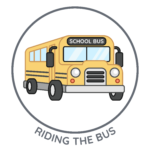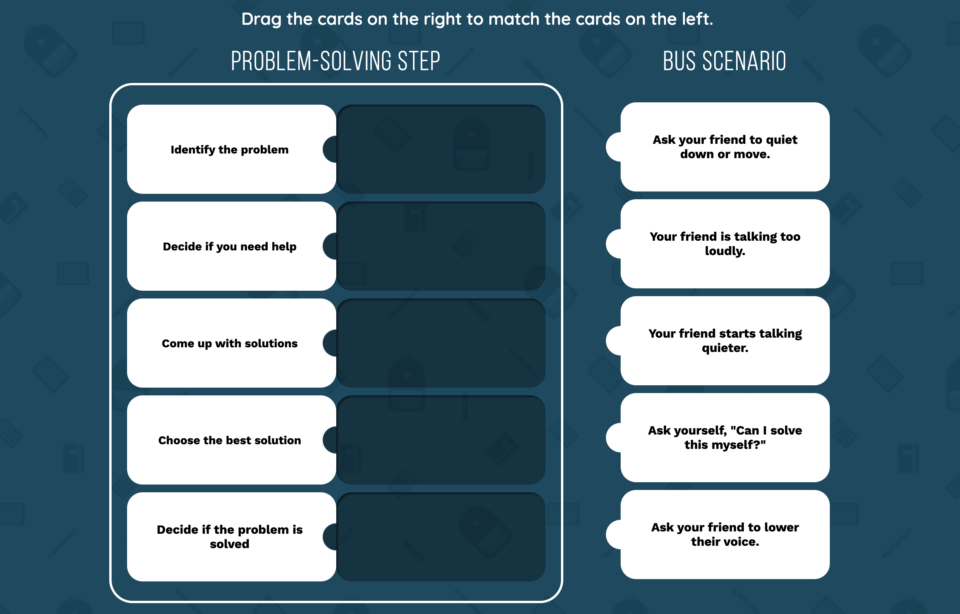
Riding the school bus is often one of the first independent experiences for elementary students. However, it also presents unique challenges. Knowing how to handle common bus issues—like friends talking too loudly or disagreements over seating—can be difficult for young learners. As an educator, you play a crucial role in equipping students with the skills they need to manage these situations effectively. Everyday Speech’s Solving Problems on the Bus Activity is designed specifically for this purpose.
The “Solving Problems on the Bus Activity” is an interactive, hands-on tool that helps students navigate common bus scenarios. Through matching cards, students learn to identify problems, come up with solutions, and make thoughtful choices. Let’s explore how you can use this activity to foster independence and problem-solving skills in your students.
What is the Solving Problems on the Bus Activity?
The Solving Problems on the Bus Activity is a structured exercise that introduces students to basic problem-solving steps using familiar bus scenarios. This activity involves matching cards to problem-solving steps like “Identify the problem” or “Choose the best solution.” Each scenario reflects realistic bus situations, helping students apply these steps in a context they understand.
This activity not only teaches students how to respond in specific situations but also equips them with a framework for problem-solving that they can use in other aspects of their lives. Everyday Speech’s approach encourages students to think critically, assess options, and take responsible actions, making it an invaluable resource for educators.

Benefits of Using the Solving Problems on the Bus Activity in Your Classroom
Using the “Solving Problems on the Bus Activity” provides several benefits for students, both in the classroom and beyond. Here’s how it can enhance students’ social skills and independence.
1. Develops Practical Problem-Solving Skills
Students learn a step-by-step approach to problem-solving, helping them understand how to handle common issues they might face on the bus.
2. Promotes Self-Reflection and Awareness
Through guided steps, students learn to assess situations and their responses, which builds self-awareness and encourages thoughtful decision-making.
3. Improves Social Interactions
This activity focuses on scenarios that require communication and empathy, like asking a friend to lower their voice. It teaches students respectful ways to interact with others.
4. Increases Confidence in Independent Situations
The more prepared students feel to handle bus scenarios, the more confident and independent they become, which is beneficial for their overall social-emotional growth.
How to Use the Solving Problems on the Bus Activity in Your Classroom
Incorporating the Solving Problems on the Bus Activity into your classroom is easy and impactful. Follow this step-by-step guide to ensure your students gain the most from the experience.
Step 1: Introduce the Concept of Problem-Solving
Start by explaining why problem-solving is important, especially in independent situations like riding the bus. Use simple language, such as “Problem-solving means finding a way to make things better.” Discuss why it’s important to stay calm and think carefully about actions.
Step 2: Present the Problem-Solving Steps
Show students the problem-solving steps that they’ll use in the activity. These include:
- Identify the problem
- Decide if you need help
- Come up with solutions
- Choose the best solution
- Decide if the problem is solved
Introduce each step and explain how it helps in finding a solution. For example, “Identify the problem” helps students clearly understand what’s going wrong, which is essential for finding the right fix.
Step 3: Practice with Bus Scenarios
Provide students with cards showing different bus scenarios, such as “Your friend is talking too loudly” or “Someone is blocking the seat.” Ask students to match each scenario to the correct problem-solving step. For instance, “Your friend is talking too loudly” would match with “Identify the problem.”
Step 4: Discuss Possible Solutions
After matching the steps, discuss possible solutions for each scenario. Encourage students to brainstorm respectful and effective ways to solve the problem. For example, if a friend is talking loudly, students might suggest saying, “Can you please talk a bit quieter?”
Step 5: Reflect and Reinforce
After completing the activity, lead a reflection session. Ask students questions like, “What would you do if this happened on the bus?” or “How would you feel if a friend asked you to quiet down?” Reflection helps students internalize the problem-solving steps and apply them in real life.
Unlock more Riding the Bus materials by signing up for your free trial today – no credit card required!
Access the full Social Communication Curriculum HERE!
Instant access to thousands of no-prep social skills activities, over 1000+ video lessons, and engaging games designed to enhance learning and development.
Everyday Speech’s Resources for Teaching Problem-Solving Skills
Everyday Speech provides a variety of resources to help educators teach social skills like problem-solving. The Solving Problems on the Bus Activity is one of many interactive tools designed to support elementary students in becoming confident, independent problem-solvers.
Everyday Speech’s curriculum includes video modeling, engaging worksheets, and guided activities that make teaching social-emotional skills simple and effective.
Conclusion: Building Independence on the Bus
The bus ride to and from school is an important part of students’ daily routine, and learning to solve problems independently in this setting is crucial. Everyday Speech’s Solving Problems on the Bus Activity empowers students with the skills they need to handle common challenges.
By integrating the Solving Problems on the Bus Activity into your classroom, you’re helping students build confidence, empathy, and resilience. These skills will not only improve their bus experiences but will also support their social and emotional growth. Give your students the tools to navigate bus scenarios and other independent situations with confidence and respect.
Sample Video
Students learn best by watching others their same-age model the behavior! Check out a sample video modeling lesson below. We offer our entire Social-Emotional Learning platform free for 14 days here!
Related Blog Posts:
Teaching Elementary Students Safe Bus Behavior
Video Modeling Lessons on Riding the Bus





